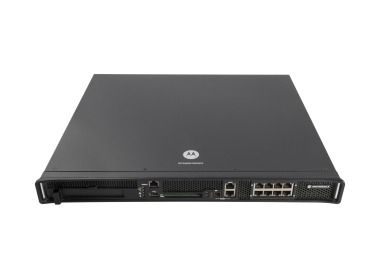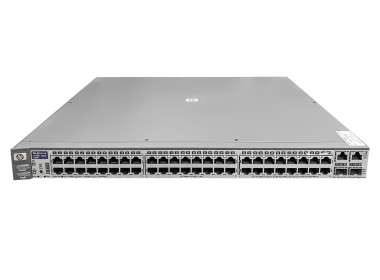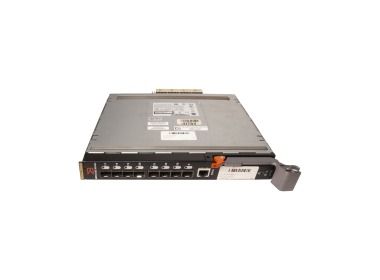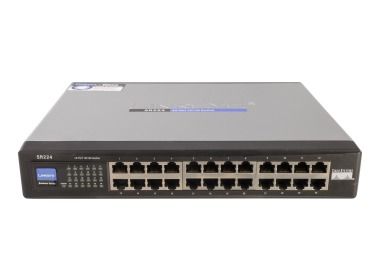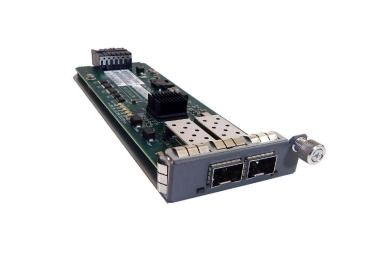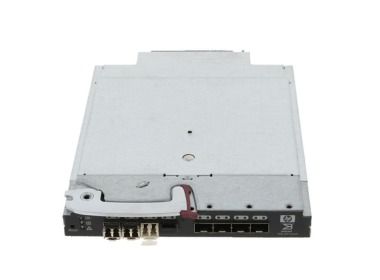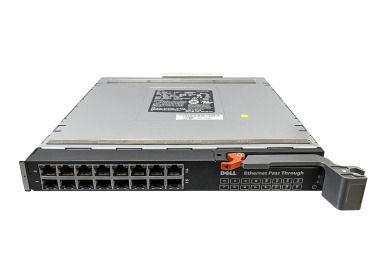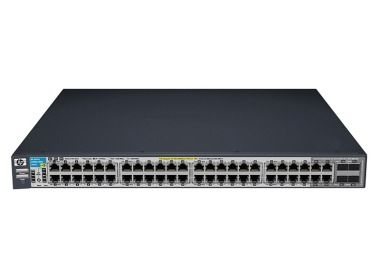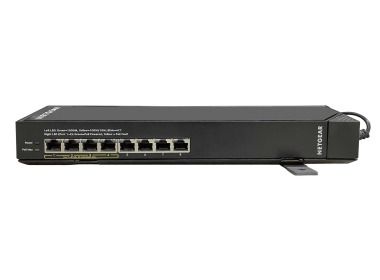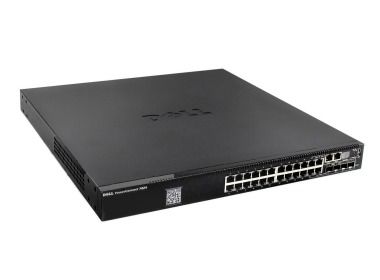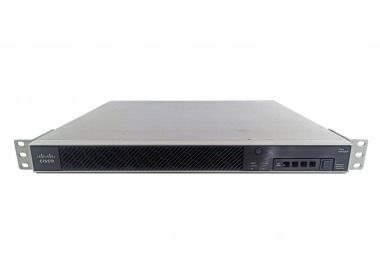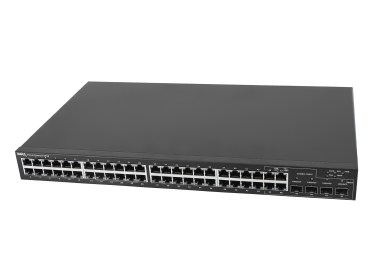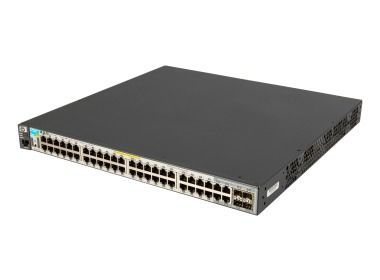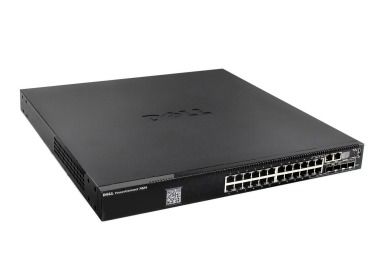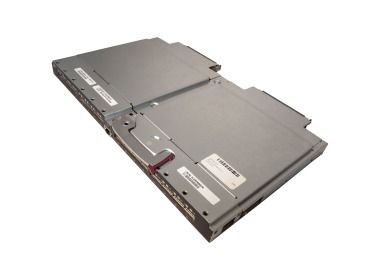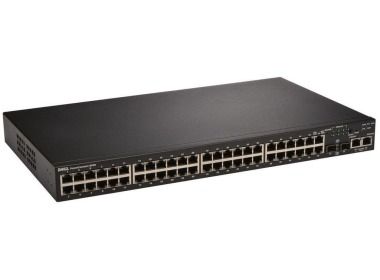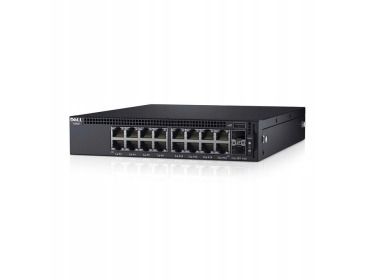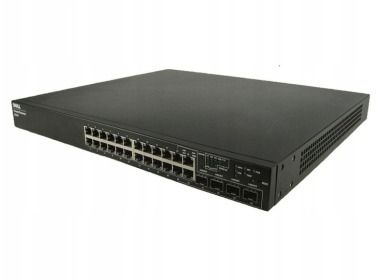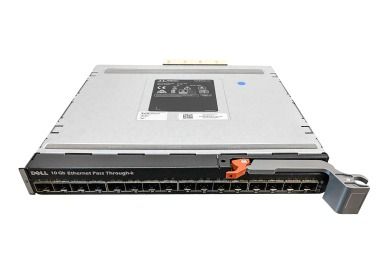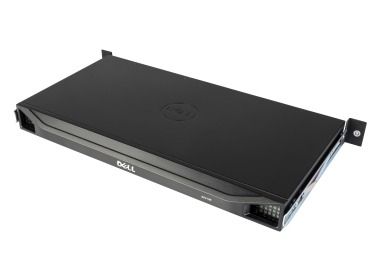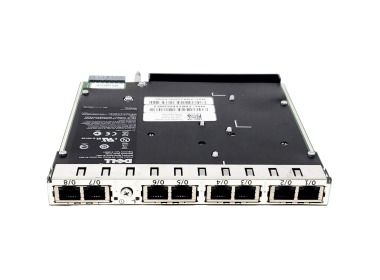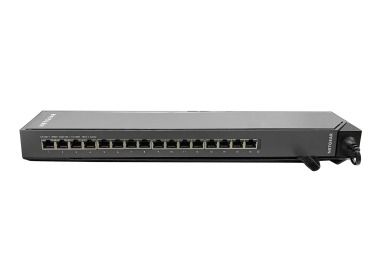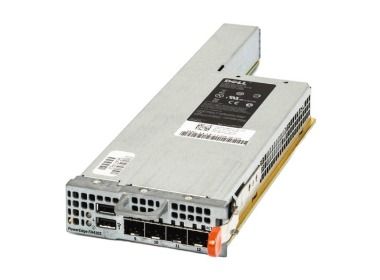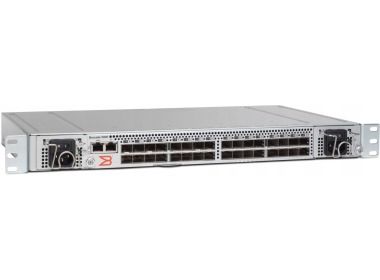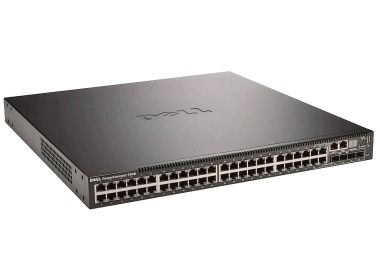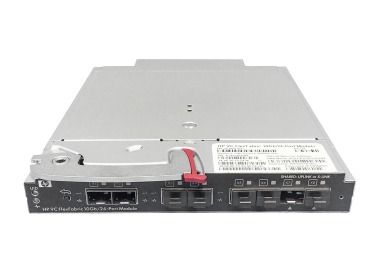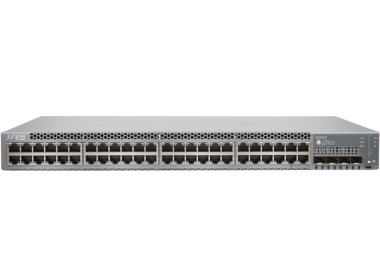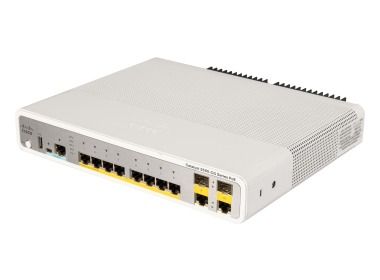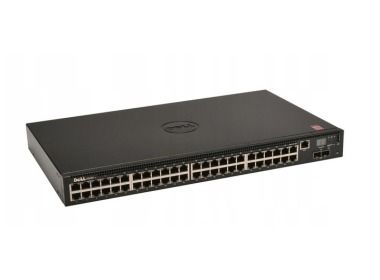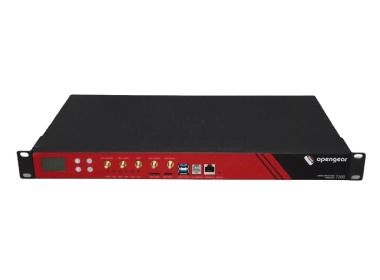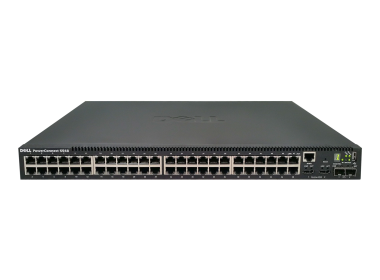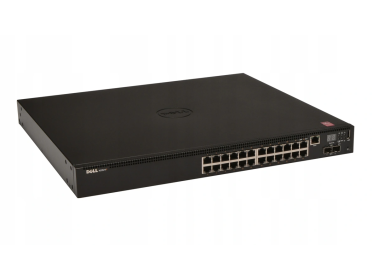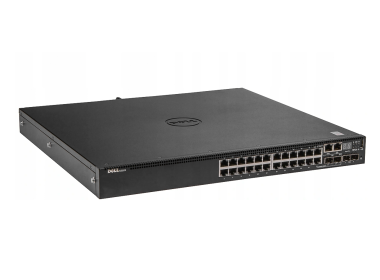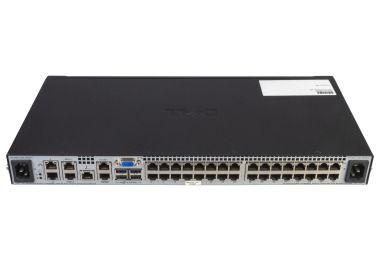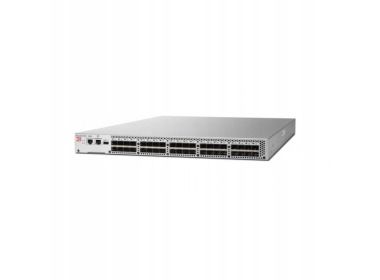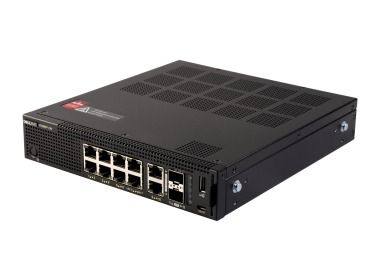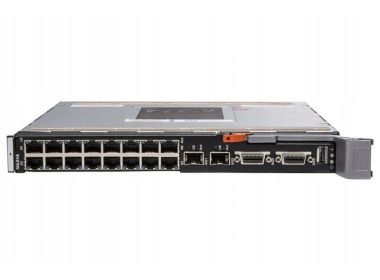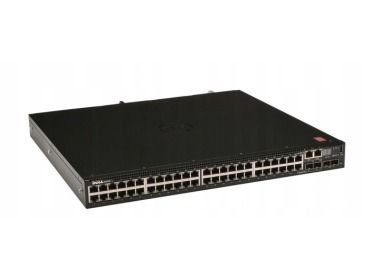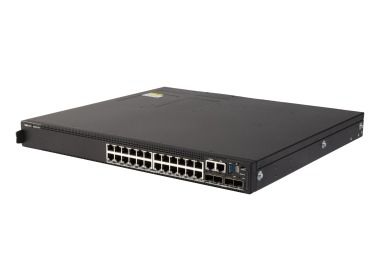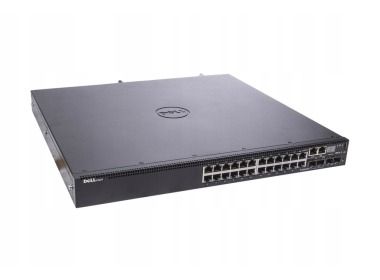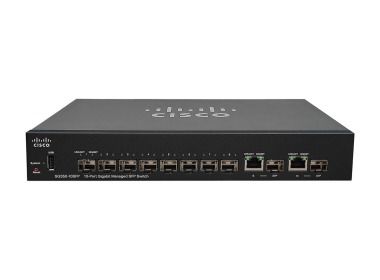- Switch Motorola RFS-6010 8x1GbE PoE RFS-6010-1000-WRTechnical parameters: Product type - Switch Width - 440mm Height - 44.45mm Depth - 390.8mm Switch type - RACK Number of 1GbE PoE ports - 8 ...Warranty 36 monthsPLN 85.01 PLN 69.11Out of stock
- Switch HPE ProCurve 2650 48x100Mb BASE-TX 2x1GbE SFPTechnical parameters: Product type - Switch Air flow - Front to rear Width - 44.25cm Height - 4.4cm Depth - 32.5cm Switching Capacity - 13.6Gbps Forwarding Cap...Calculating delivery time...In stock 4Warranty 36 monthsPLN 100.00 PLN 81.30
- Switch Dell Brocade M5424 24x8Gb FC for PowerEdge M1000e J493TTechnical parameters: Air flow - Not applicable Width - 272.75mm Height - 32.48mm Depth - 307.24mm Switching Capacity - 384Gbps Forwarding Capacity - 128Gpps S...Calculating delivery time...In stock 16Warranty 36 monthsPLN 120.00 PLN 97.56
- Switch Cisco Catalyst 3130X 4x1GbE RJ45 2x10GbE SFP for Dell PowerEdge M1000eTechnical parameters: Width - 24.8cm Height - 2.9cm Depth - 23.1cm Switching Capacity - 128Gbps Number of 1GbE ports - 4 Switch type - Switch for Dell M1000E M...Calculating delivery time...In stock 4Warranty 36 monthsPLN 130.00 PLN 105.69
- Switch Dell PowerConnect M6220 4x10GbE BASE-T 16x10GbE BASE-T Internal 1x Module 2x10GbE CX4This set contains: Technical parameters: Product type - Switch Width - 267mm Height - 31nm Depth - 258mm Switching Capacity - 128Gbps Forwarding Capacity - 95M...Calculating delivery time...In stock 3Warranty 36 monthsPLN 140.00 PLN 113.82
- Switch Cisco LINKSYS SR224 24x100MbE SR224 v2.0Technical parameters: Product type - Switch Air flow - Not applicable Width - 279.4mm Height - 44.5mm Depth - 240mm Switching Capacity - 200Mbps Forwarding Cap...Calculating delivery time...In stock 10Warranty 36 monthsPLN 140.00 PLN 113.82
- Module for network device Dell Force10 2x10GbE SFP+ 2P8V4Technical parameters: ...Calculating delivery time...In stock 4Warranty 12 monthsPLN 140.00 PLN 113.82
- Switch HPE Brocade Bladesystem C7000 Enclosure 4/24 SAN 411120-001Technical parameters: Switch type - Brocade Bladesystem ...Calculating delivery time...In stock 2Warranty 36 monthsPLN 140.00 PLN 113.82
- Switch Brocade PowerEdge M1000e 24x8Gb FCTechnical parameters: Product type - Switch Air flow - Not applicable Width - 272.75mm Height - 32.48mm Depth - 307.24mm Switch type - Switch for Dell M1000E M...Calculating delivery time...In stock 1Warranty 36 monthsPLN 150.00 PLN 121.95
- Switch Dell PowerEdge M1000e 16x1GbE RJ45Technical parameters: Product type - Switch Number of 1GbE ports - 16 Switch type - Switch for Dell M1000E ...Calculating delivery time...In stock 3Warranty 36 monthsPLN 170.00 PLN 138.21
- Switch HPE 3500yl-48G J8693A 48x10/100/1000 4xSFPTechnical parameters: Product type - Switch ...PLN 180.00 PLN 146.34Out of stock
- Switch NetGear 4x1GbE RJ45 4x1GbE PoE GSS108EPPTechnical parameters: Air flow - Not applicable Width - 305mm Height - 35mm Depth - 65mm Switching Capacity - 16Gbps Forwarding Capacity - 11.9Mpps Number of 1...Warranty 36 monthsPLN 230.00 PLN 186.99Out of stock
- Switch Dell PowerConnect 7024 24x1GbE RJ45 F2RTechnical parameters: Product type - Switch Air flow - Front to rear Width - 440mm Height - 44mm Depth - 460mm Switching Capacity - 176Gbps Forwarding Capacity...Calculating delivery time...In stock 2Warranty 36 monthsPLN 230.00 PLN 186.99
- Switch Cisco MDS 9148S 48x16Gb FC (12-Active Ports) R2F Reverse Flow, 2xPSU, 2xFANThis set contains: 1x Switch Cisco MDS 9148S 48x16Gb FC (12x ACTIVE) 2x Power supply unit for Cisco MDS 9148S switch 2x Fan for Cisco MDS 9148S switch Technica...Calculating delivery time...In stock 4Warranty 36 monthsPLN 250.00 PLN 203.25
- Switch Cisco Meraki MS120-8LP 2x1GbE SFP 8x1GbE PoE+, NO PSUTechnical parameters: Product type - Switch Width - 222mm Height - 28mm Depth - 150mm Switching Capacity - 20Mbps Forwarding Capacity - 14.88Mpps Switch type -...Warranty 36 monthsPLN 250.00 PLN 203.25Out of stock
- Switch Cisco Firewall Adaptive Security ASA 5525-X ASA5525 V05Technical parameters: Product type - Firewall Width - 20cm Height - 4.45cm Depth - 36.2cm Number of 1GbE ports - 8 Maximum input power - 108W ...PLN 250.00 PLN 203.25Out of stock
- Switch Dell PowerConnect 5448 48x1GbE RJ45Technical parameters: Product type - Switch Width - 440mm Height - 44mm Depth - 253mm Switching Capacity - 96Gbps Forwarding Capacity - 71.2Mpps Number of 1GbE...Warranty 36 monthsPLN 260.00 PLN 211.38Out of stock
- Switch HP ProCurve 3500yl-48G-PoE+ 44x1GbE BASE-T Auto-MDIX 4x1GbE SFP J9311ATechnical parameters: Product type - Switch Width - 443mm Height - 44mm Depth - 430mm Switching Capacity - 148Mbps Switch type - RACK Number of 1GbE SFP ports ...Warranty 36 monthsPLN 270.00 PLN 219.51Out of stock
- Switch Cisco Catalyst 3850 48x1Gb RJ-45 PoE+ 1xPSU 715W WS-C3850-48P-LTechnical parameters: Product type - Switch Width - 44.5cm Height - 4.45cm Depth - 45cm Switching Capacity - 176Gbps Forwarding Capacity - 130.95Mpps Additiona...Warranty 36 monthsPLN 310.00 PLN 252.03Out of stock
- Switch Dell PowerConnect 7024 24x1GbE BASE-T F2R Normal Flow 1x Module 2x10GbE CX4This set contains: Technical parameters: Product type - Switch Air flow - Front to rear Width - 440mm Height - 44mm Depth - 460mm Switching Capacity - 176Gbps ...Warranty 36 monthsPLN 320.00 PLN 260.16Out of stock
- Switch Cisco 2960C 12x100MbE RJ45 PoE 2x1Gb Uplink WS-C2960C-12PC-LTechnical parameters: Product type - Switch Width - 269mm Height - 46mm Depth - 239mm Switch type - Switch Rack half-width Number of 100Mbps ports - 12 PSU cur...Warranty 36 monthsPLN 340.00 PLN 276.42Out of stock
- Switch Quanta LB4M 48x1GbE 2x10GbE SFP+ 2xPSU, 3xFANThis set contains: 1x Switch Quanta LB4M 48x1GbE 2x10GbE SFP+ 2x Power supply unit for Quanta LB4M switch 300W 100-240V AC 80+ 1x Fan module for Quanta LB4M sw...Calculating delivery time...In stock 2Warranty 36 monthsPLN 350.00 PLN 284.55
- Switch HPE BLc 4x QDR 16x40GbE QSFP+ 489184-B21Technical parameters: Air flow - Not applicable Width - 374.7mm Height - 63.5mm Depth - 508mm Number of 40GbE QSFP+ ports - 16 Switch type - Switch for HP Blad...Calculating delivery time...In stock 6Warranty 36 monthsPLN 350.00 PLN 284.55
- Switch Dell PowerConnect 3548 48x100MB BASE-T 2x1GB SFPTechnical parameters: Product type - Switch Width - 43.94cm Height - 4.32cm Depth - 38.61cm Switching Capacity - 17.6Gbps Forwarding Capacity - 13.1Mpps Number...Calculating delivery time...In stock 4Warranty 36 monthsPLN 350.00 PLN 284.55
- Switch Dell Force10 X1018 16x1GbE RJ45 2x1GbE SFP TXG9GTechnical parameters: Product type - Switch Air flow - Not applicable Width - 209mm Height - 41.25mm Depth - 250mm Switching Capacity - 36Gbps Forwarding Capac...Calculating delivery time...In stock 22Warranty 36 monthsPLN 370.00 PLN 300.81
- Switch Dell PowerConnect 3548P 2x1GbE SFP 2x1GbE RJ45 48x100MbETechnical parameters: Product type - Switch Width - 43.94cm Height - 4.32cm Depth - 38.61cm Switching Capacity - 17.6Gbps Forwarding Capacity - 13.1Mpps Number...Calculating delivery time...In stock 1Warranty 36 monthsPLN 420.00 PLN 341.46
- Switch Dell PowerConnect 5324 24x1GbE RJ45Technical parameters: Width - 440mm Height - 44mm Depth - 253mm Number of 1GbE ports - 24 Switch type - RACK ...Calculating delivery time...In stock 2Warranty 36 monthsPLN 430.00 PLN 349.59
- Switch Dell M1601P 16x10Gb BASE-KX4 Internal 16x10GbE SFP+ Pass Through IITechnical parameters: Product type - Switch Width - 24.69cm Height - 2.9cm Depth - 28.5cm Amount of 10GbE SFP+ ports - 16 Switch type - Switch for Dell M1000E ...Calculating delivery time...In stock 2Warranty 36 monthsPLN 460.00 PLN 373.98
- Switch Cisco Catalyst 2960CX-8TC-L 8x1GbE BASE-T 2x Dual Uplink, LAN Base WS-C2960CX-8TC-LTechnical parameters: Product type - Switch Width - 269mm Height - 45mm Depth - 213mm Switching Capacity - 24Gbps Forwarding Capacity - 12Gpps Number of 1GbE p...Warranty 36 monthsPLN 460.00 PLN 373.98Out of stock
- Switch KVM Dell AV2108 8x1GbE RJ45 KVM 1xACI 2x1GbE RJ45 4xUSB 1xVGA 1U 520-665-502Technical parameters: Product type - Switch KVM ...Warranty 36 monthsPLN 460.00 PLN 373.98Out of stock
- Switch Dell R1-2401 for PowerEdge VRTX 8x1GbE RJ45 H4THXTechnical parameters: Product type - Switch Air flow - Not applicable Number of 1GbE ports - 8 Switch type - Switch for Dell VRTX ...Warranty 36 monthsPLN 470.00 PLN 382.11Out of stock
- Switch NetGear Plus Click GSS116E 16x1GbE BASE-T FanlessTechnical parameters: Product type - Switch Width - 407mm Height - 36mm Depth - 70mm Switching Capacity - 32Gbps Forwarding Capacity - 23.8Mpps Number of 1GbE ...Warranty 36 monthsPLN 490.00 PLN 398.37Out of stock
- Switch Cisco SF300-24PP 24x100MbE POE+ 2x1Gb SFP 2x1Gb RJ45Technical parameters: Product type - Switch Width - 44nm Height - 4.3cm Depth - 25.6nm Switch type - RACK Number of 1GbE SFP ports - 2 Number of 1GbE RJ45 port...Calculating delivery time...In stock 4Warranty 36 monthsPLN 500.00 PLN 406.50
- Dell Module FN410S 4x10GbE SFP+ for PowerEdge FX2/FX2S T6W0JTechnical parameters: Air flow - Not applicable Switching Capacity - 240Gbps Forwarding Capacity - 179Mpps Amount of 10GbE SFP+ ports - 4 Switch type - Switch ...Warranty 12 monthsPLN 549.99 PLN 447.15Out of stock
- Switch Brocade 5000 32x4Gb FC 24 active portsTechnical parameters: Width - 42.9cm Height - 4.4cm Depth - 26.4cm Switch type - RACK Ilość portów 4Gb FC - 32 ...Calculating delivery time...In stock 5Warranty 36 monthsPLN 650.01 PLN 528.46
- Switch Dell PowerConnect 7048 48x1GbE RJ45 R2F Reverse Flow C05J0Technical parameters: Air flow - Rear to front Width - 440mm Height - 44mm Depth - 460nm Switching Capacity - 224Gbps Forwarding Capacity - 160Mpps Number of 1...Warranty 36 monthsSpecial offer available until further notice.Special Price PLN 650.01 PLN 528.46 Regular Price PLN 970.00Out of stock
- Switch HPE Virtual Connect Flexfabric 4x10GbE SFP+ 4x8Gb FC 16x10GbE BASE-KR Internal 571956-B21Technical parameters: Product type - Switch Air flow - Not applicable Amount of 10GbE SFP+ ports - 4 Switch type - Switch Kasetowy Ilość portów wewnętrznyc...Calculating delivery time...In stock 1Warranty 36 monthsPLN 680.01 PLN 552.85
- Switch Juniper Networks EX2300-48T 48x1GbE 4x10GbE SFP+Technical parameters: Product type - Switch Width - 446mm Height - 44.5mm Depth - 259mm Switching Capacity - 176Gbps Forwarding Capacity - 130Mpps Number of 1G...Calculating delivery time...In stock 2Warranty 36 monthsPLN 750.00 PLN 609.76
- Switch Cisco Catalyst 3560-CG-8PC-S 8x1GbE BASE-T PoE+ 124W 2x Dual Uplink, IP Base WS-C3560CG-8PC-STechnical parameters: Product type - Switch Width - 269mm Height - 45mm Depth - 238mm Forwarding Capacity - 10Gpps Switch type - Switch Rack half-width Number ...Warranty 36 monthsPLN 750.00 PLN 609.76Out of stock
- Cisco Nexus 7700 F3-Series 24x 40 Gb Ethernet Module N77-F324FQ-25Technical parameters: Switching Capacity - 960Gbps Forwarding Capacity - 1440Mpps Number of 40GbE QSFP+ ports - 24 Switch type - RACK Maximum input power - 650...Calculating delivery time...In stock 8Warranty 36 monthsPLN 760.00 PLN 617.89
- Switch Dell Networking N2048 2x10GbE SFP+ 48x1GbE RJ45 F2RTechnical parameters: Air flow - Front to rear Width - 440mm Height - 43.5mm Depth - 257mm Switching Capacity - 220Gbps Forwarding Capacity - 164Mpps Number of...Warranty 36 monthsPLN 800.00 PLN 650.41Out of stock
- Switch HPE SN3000B 24x16Gb FC 12x Active Ports R2F Reverse Flow 2x PSUTechnical parameters: Air flow - Rear to front Width - 438mm Height - 43mm Depth - 443mm Switching Capacity - 384Gbps Switch type - RACK Maximum input power - ...Calculating delivery time...In stock 10Warranty 36 monthsPLN 800.00 PLN 650.41
- Opengear 48 Port Console Manager LTE Dual AC IM7248-2-DAC-LMATechnical parameters: Number of 1GbE ports - 2 Additional modules slots - 2 PSU maximum count - 2 Maximum input power - 60W Additional notes - 48x RJ-45; 4G LT...Warranty 36 monthsPLN 810.00 PLN 658.54Out of stock
- Switch Dell Networking N2024 2x10GbE SFP+ 24x1GbE RJ45 F2RTechnical parameters: Air flow - Front to rear Width - 440mm Height - 43.5mm Depth - 257mm Switching Capacity - 172Gbps Forwarding Capacity - 128Mpps Number of...Calculating delivery time...In stock 10Warranty 36 monthsPLN 900.00 PLN 731.71
- Switch Dell PowerConnect 5548 2x10GbE SFP+ 48x1GbE RJ45Technical parameters: Product type - Switch Width - 440mm Height - 43.2mm Depth - 257mm Switching Capacity - 176Gbps Forwarding Capacity - 100.2Mpps Number of ...Calculating delivery time...In stock 1Warranty 36 monthsPLN 930.00 PLN 756.10
- Switch Dell Networking N2024P 24x1GbE PoE+ 2x10GbE SFP+ R2FTechnical parameters: Air flow - Rear to front, Front to rear Width - 440mm Height - 43.5mm Depth - 387mm Switching Capacity - 172Gbps Forwarding Capacity - 12...Calculating delivery time...In stock 17Warranty 36 monthsPLN 990.00 PLN 804.88
- Switch Dell Networking N3024 24x1GbE BASE-T 2x10GbE SFP+ F2R Normal Flow, 1x PSU, 1x FanThis set contains: 1x Switch Dell Networking N3024 24x1GbE BASE-T 2x10GbE SFP+ 1x Dell power supply for N3024 200W F2R Normal Flow 100-240V AC 50/60MHz 1x Fan ...Calculating delivery time...In stock 16Warranty 36 monthsPLN 1,000.00 PLN 813.01
- Switch Dell PowerEdge KVM 4322DS 32x1GbETechnical parameters: Number of 1GbE ports - 32 Switch type - RACK ...Warranty 36 monthsPLN 1,050.00 PLN 853.66Out of stock
- Switch Dell Brocade 5100 40x8Gb FC 2xPSU G094GTechnical parameters: Width - 272.75mm Height - 32.48mm Depth - 307.24mm Switch type - RACK Number of 8Gb FC ports - 40 ...Calculating delivery time...In stock 1Warranty 36 monthsPLN 1,070.00 PLN 869.92
- Switch Dell Networking N1108EP-ON 8x1GbE PoE 2x1GbE 2x1GbE SFP HK2G1Technical parameters: Product type - Switch Air flow - Not applicable Width - 209mm Height - 41.1mm Depth - 225mm Switching Capacity - 24Gbps Forwarding Capaci...Warranty 36 monthsPLN 1,100.00 PLN 894.31Out of stock
- Switch Dell PowerSwitch N1108EP-ON 8x1GbE PoE+ 2x1GbE SFP 2x1GbE RJ45Technical parameters: Product type - Switch Air flow - Not applicable Width - 209mm Height - 41.1mm Depth - 225mm Switching Capacity - 24Gbps Forwarding Capaci...Calculating delivery time...In stock 9Warranty 36 monthsPLN 1,100.00 PLN 894.31
- Switch Dell Networking M6348 48x1GbE BASE-T 2x10GbE SFP+ 2x32GbE CX4 PC-M6348Technical parameters: Product type - Switch Air flow - Not applicable Width - 267mm Height - 31mm Depth - 258mm Number of 1GbE ports - 48 Amount of 10GbE SFP+ ...Calculating delivery time...In stock 3Warranty 36 monthsPLN 1,120.00 PLN 910.57
- Switch Dell Networking N3048P 48x1GbE PoE 2x10GbE SFP+ F2R FKJ36Technical parameters: Air flow - Front to rear Width - 434mm Height - 43.5mm Depth - 407mm Switching Capacity - 260Gbps Forwarding Capacity - 193Mpps Amount of...Warranty 36 monthsPLN 1,150.00 PLN 934.96Out of stock
- Switch Dell Networking N3048 48x1GbE RJ45 2x10GbE SFP+ F2R Normal Flow 2xPSU 1xFanThis set contains: 1x Switch Dell Networking N3048 2x PSU for Dell N3048 switch 200W AC F2R 1x Fan for Dell N3048 switch Standard F2R Technical parameters: Air...Warranty 36 monthsPLN 1,150.00 PLN 934.96Out of stock
- Switch Dell PowerSwitch N2224X-ON 24x2.5GbE BASE-T 4x10/25GbE SFP28 2xFAN, 1xPSUTechnical parameters: Product type - Switch Width - 43.4cm Height - 4.35cm Depth - 40cm Switching Capacity - 480Gbps PSU maximum count - 2 Number of 10/25GbE S...Calculating delivery time...In stock 17Warranty 36 monthsSpecial price ends on 2026-01-01Special Price PLN 1,217.70 PLN 990.00 Regular Price PLN 3,075.00
- Switch Dell Networking N3024 24x1GbE BASE-T 2x10GbE SFP+ F2R Normal Flow, 2x PSU, 1x FanTechnical parameters: Product type - Switch Air flow - Front to rear Width - 434mm Height - 43.5mm Depth - 407mm Switching Capacity - 212Gbps Forwarding Capaci...Calculating delivery time...In stock 10Warranty 36 monthsPLN 1,220.00 PLN 991.87
- Switch Dell Force10 S60 44x1GbE BASE-T 4x1GbE SFP F2R Normal Flow 1xPSU 1xModule uplink 2x10GbE SFP+ 1xModule stack 2xSFF-8470This set contains: Technical parameters: Product type - Switch Air flow - Front to rear Width - 44cm Height - 4.3cm Depth - 42.5cm Switching Capacity - 176Gbps...Calculating delivery time...In stock 1Warranty 36 monthsPLN 1,220.00 PLN 991.87
- Switch Dell S3124 2x10GbE SFP+ 24x1GbE RJ45 F2RTechnical parameters: Air flow - Front to rear Width - 43.4cm Height - 4.35cm Depth - 40.7cm Switching Capacity - 212Gbps Forwarding Capacity - 158Mpps Number ...Calculating delivery time...In stock 2Warranty 36 monthsPLN 1,290.00 PLN 1,048.78
- Switch Cisco 2x1GbE RJ45 10x1GbE SFPTechnical parameters: Product type - Switch Air flow - Not applicable Width - 279.4mm Height - 44mm Depth - 170mm Forwarding Capacity - 20Gpps Number of 1GbE p...Warranty 36 monthsPLN 1,300.00 PLN 1,056.91Out of stock
- Switch Dell PowerConnect 8132 24x10GbE BASE-T 2x PSU, 2x Fan, F2R Normal FlowThis set contains: 1x Switch Dell PowerConnect 8132 24x10GbE BASE-T 2x PSU for Dell 8132 switch 460W 200-240V AC 80+ Gold F2R Normal Flow 2x Fan for Dell 8132 ...Warranty 36 monthsPLN 1,350.00 PLN 1,097.56Out of stock
Network switches are the foundation of any IT infrastructure – from simple offices to complex data centers. At Hardware Direct, you'll find models tailored to every scale and application: from simple plug-and-play units to advanced Layer 3 switches with 40GbE uplinks, PoE+, and inter-VLAN routing. Find out what will genuinely speed up and secure your network.
Switches – The Solid Backbone of Every Network, from Office to Data Center
Without an efficient switch, a network is just a collection of cables and devices that "wish they could communicate." Switches are what actually tie them together – transferring data, prioritizing traffic, powering devices, and ensuring the entire system operates stably. Hardware Direct offers over 150 models – from the simplest unmanaged switches starting at 69 PLN, to advanced units with Layer 3 routing, 40GbE uplinks, and the possibility of expansion with additional modules. With them, you can build everything – from a home NAS network, through an office with Wi-Fi 6 and IP surveillance, to a high-performance data center environment with a spine-leaf topology.
Network switches differ in features, performance, and range of applications – but their common goal is one: to provide fast, reliable, and scalable communication between devices. That's why we only offer models from trusted manufacturers – Dell, Cisco, HPE, NetGear, Brocade – ready to work in any conditions. Need VLANs, PoE+, SNMP, redundancy, or MACsec encryption? You have it all in one place.
Which Network Switch for Your Network? From Home Plug-and-Play to Data Center Hardware
For small offices and local networks, unmanaged switches like the Cisco LINKSYS SR224 are perfectly sufficient – simple, stable, and inexpensive, with no configuration needed. Ideal for basic tasks: network printers, IP cameras, NAS, internet access. However, if you manage traffic, create separate VLANs, apply QoS for VoIP, or need port monitoring – you can't do without a managed switch. Models like the Dell PowerConnect 5548 or HPE 3500yl allow you to create an extensive, organized network with full control at Layer 2.
For larger environments – with VLAN segmentation, the need for inter-subnet routing, and high-speed uplinks – consider Layer 3 switches with L3 routing features, OSPF, or BGP. The Cisco Catalyst 3850 is an excellent example: up to 715W PoE+, StackWise for stacking multiple devices, and full support for segmentation and enterprise-class security. And if you're building a backbone network – with several core switches and an access layer – choose modular hardware like the Dell PowerSwitch N2224X with 25/40GbE ports, ready for spine-leaf topologies.
Need VLANs, QoS, and Routing? Discover What Layer 2 and Layer 3 Managed Network Switches Offer
Managed switches are in a completely different league. They allow you not only to connect devices into a network but to consciously design and optimize it. VLANs enable traffic segmentation and increase security. QoS ensures that important packets – like VoIP voice or camera data – get priority. STP and RSTP protocols prevent network loops, and features like port mirroring allow you to monitor and diagnose traffic. With SNMP support, you can centrally manage the entire infrastructure – even from the cloud.
Layer 3 (L3) models go a step further – enabling routing between VLANs, which reduces the load on edge routers and increases internal communication performance. For example, the Dell PowerConnect 5548 supports 2x10GbE uplinks, has 176 Gbps throughput, and management via CLI, web GUI, or Telnet. The Cisco Catalyst 3850 or HPE 3800 are solutions for corporate environments – with support for BGP, OSPF, and even IPv6 and TrustSec. This level allows integrating the network with access policies, user identity, and security systems.
Have IP Surveillance, Wi-Fi 6, or VoIP? Choose a Switch with PoE+ That Can Power Your Devices
Not every network needs separate power supplies, cables, and UPS units for each device. Thanks to PoE and PoE+ technology (IEEE 802.3af/at), you can power cameras, IP phones, Wi-Fi access points, or POS terminals directly through the network port – without additional cables. This is not only convenient but also saves time and deployment costs. Our offer includes models providing up to 30W per port, with total power budgets exceeding 700W – as seen in the Cisco Catalyst 3850.
For smaller environments, 8–24 port switches with PoE are ideal – e.g., the Motorola RFS-6010 with a 124W budget, great for an office with IP surveillance. For Wi-Fi 6 or networks with heavy multicast traffic, consider devices with a dynamic buffer (SmartBuffer) and 2.5/5GbE uplinks that don't throttle traffic. Additional benefits include features like auto-discovery, scheduled PoE reboots, and power drop alerts – crucial in environments where continuous operation is key.
Want to Expand Your Network with 10/25/40GbE? Explore Spine/Leaf Models Ready for Scaling
When your network starts to grow, you need hardware that scales with it. Modular and high-throughput switches are fundamental to modern data center topologies – especially in spine-leaf models, where performance and low latency are critical. Models like the Dell PowerSwitch N2224X-ON or Cisco Nexus 7700 offer 25/40/100GbE uplink ports, support MLAG, VXLAN, dynamic segmentation, and zero-touch provisioning.
For VDI deployments, environments with NVMe-over-Fabrics arrays, or high port density networks, it's worth choosing devices with MACsec support (256-bit traffic encryption at the port level), power redundancy, and passive cooling. Additional features, such as FlexAddress (Dell) or Dynamic Segmentation (HPE), provide even greater flexibility during migrations, reconfigurations, and resource allocation. These aren't "premium" features – they are standard where infrastructure must run continuously, without exception.








